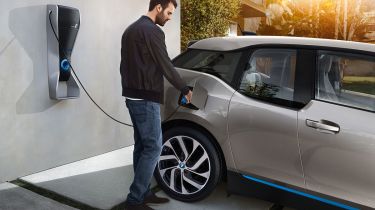Tethered or untethered home charger?
Find out if you should buy a tethered or untethered EV charger and what the differences are between them

One of the first things you need to think about when considering an electric car is how you will charge it. As public chargers remain expensive and mostly inconvenient, home wallbox chargers are by far the best way to charge your electric car. However, there are two versions of home charger you need to be aware of: tethered and untethered. So how do you choose which one is best for you? We break down the differences below.
So, what is the difference between a tethered and untethered EV charger? It sounds a bit strange at first but it’s pretty simple: a tethered charger is a box fixed in place on the wall with a built-in cable that you unhook from its docking point and plug into your electric (or plug-in hybrid) car. As you would normally do, once the car is finished charging or you need to head out, you simply unplug, hook the cable back to its docking point and you’re done.
An untethered EV charger differs as it doesn’t have its own built-in charging cable. Instead it has a slot to plug in your own charging cable to the wallbox and once that is connected you simply plug in your car as you would with a tethered charger. Then, once the charging has ended you disconnect both ends of the cable and store it elsewhere, most EVs have a built-in storage place for the cable so you can use it on longer journeys.
There are some pros and cons to each type of home wallbox charger, plus they are usually priced differently. In this quick guide we will put the two types (tethered vs untethered charger) against each other to find out which one is best for you, so read below to find out everything you need to know.
Check out our list of the best home electric car chargers for our recommendations for the best chargers you can buy, chosen by our team of experts. Follow us at DrivingElectric on Twitter, Facebook, Instagram and YouTube for all the latest news and reviews from the world of hybrid and electric cars.
Tethered wallbox chargers
Tethered wallbox chargers are the more convenient type for most people, especially if you plan to charge up every night, as most drivers do. You simply pull up to the wallbox, grab the cable and plug in, so it’s nice and quick. There are some drawbacks, though.
You have to make sure you wind the cable back up and store it neatly every time you unplug your car, otherwise you risk driving over it or damaging it in some other way. You also need to check if the built-in cable is long enough to reach your parking space, otherwise you’ll need to pay extra for a longer cable when ordering your unit.

There’s also a slight possibility that by choosing a tethered charger you could end up with a box that you can’t use in the future. It seems unlikely that anything other than Type 2 will be the norm in the years to come, but advances in tech could make it obsolete. Most EVs use Type 2 plugs for charging – think of it like the USB of the car world – but some older models such as the Nissan Leaf used a different set-up that’s not compatible.
Untethered wallbox chargers
Untethered wallbox chargers require you to connect your own cable to use them. Most cars come with this as standard, but sometimes it’s an optional extra and can cost hundreds to replace if you lose it. It’s more inconvenient than a tethered charger because every time you arrive home, you’ll need to open the boot, or wherever the cables are stored in the car, get them out and plug in at both ends. Then you have to do the reverse when you set off.
However, without a cable, untethered units look a bit tidier on your driveway, and you can purchase cables of different lengths as required. They’re also the best way of future-proofing your charger, as you can simply upgrade the plug configuration when you need to. Plus, they’re generally less expensive than tethered chargers because manufacturers don’t have to provide any charging cable.
Should you choose tethered or untethered?
Realistically, neither is better or worse than the other; the choice is purely based on your preference and requirements. Untethered chargers are likely more flexible in terms of cable length and the type of cable you need. However, in comparison, the tethered charger is objectively easier to use, with the cable already attached and available from the moment it’s installed.
When choosing, make sure to consider both options to see which best matches your requirements. Before having one installed, always have an approved electrician evaluate the work required to provide you with an accurate quote. They will likely offer guidance on which option is most suited to you, but ultimately, the choice is yours
